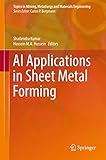AI Applications in Sheet Metal Forming [electronic resource] / edited by Shailendra Kumar, Hussein M. A. Hussein.
Contributor(s): Kumar, Shailendra [editor.] | Hussein, Hussein M. A [editor.]
| Hussein, Hussein M. A [editor.] | SpringerLink (Online service)
| SpringerLink (Online service) .
.
Material type:  BookSeries: Topics in Mining, Metallurgy and Materials Engineering: Publisher: Singapore : Springer Nature Singapore : Imprint: Springer, 2017Edition: 1st ed. 2017.Description: XII, 290 p. 231 illus. online resource.Content type: text Media type: computer Carrier type: online resourceISBN: 9789811022517.Subject(s): Metals
BookSeries: Topics in Mining, Metallurgy and Materials Engineering: Publisher: Singapore : Springer Nature Singapore : Imprint: Springer, 2017Edition: 1st ed. 2017.Description: XII, 290 p. 231 illus. online resource.Content type: text Media type: computer Carrier type: online resourceISBN: 9789811022517.Subject(s): MetalsAn overview of applications of artificial intelligence (AI) in sheet metal work -- Generic classification and representation of shape features in sheet-metal parts -- Feature Extraction and Manufacturability Assessment of Sheet Metal Parts -- Knowledge Based System for Design of Blanking Dies -- Knowledge-Based System for Design of Deep Drawing Die for Axisymmetric Parts -- An Integrated Approach for Optimized Process Planning of Multistage Deep Drawing -- Knowledge Based System for Design of Deep Drawing Die for Elliptical Shape Parts -- An Expert System for Automatic Design of Compound Dies -- Prediction of Die Life of Compound Die using ANN -- Knowledge Based System for Automatic Design of Bending Dies.
This book comprises chapters on research work done around the globe in the area of artificial intelligence (AI) applications in sheet metal forming. The first chapter offers an introduction to various AI techniques and sheet metal forming, while subsequent chapters describe traditional procedures/methods used in various sheet metal forming processes, and focus on the automation of those processes by means of AI techniques, such as KBS, ANN, GA, CBR, etc. Feature recognition and the manufacturability assessment of sheet metal parts, process planning, strip-layout design, selecting the type and size of die components, die modeling, and predicting die life are some of the most important aspects of sheet metal work. Traditionally, these activities are highly experience-based, tedious and time consuming. In response, researchers in several countries have applied various AI techniques to automate these activities, which are covered in this book. This book will be useful for engineers working in sheet metal industries, and will serve to provide future direction to young researchers and students working in the area.


There are no comments for this item.